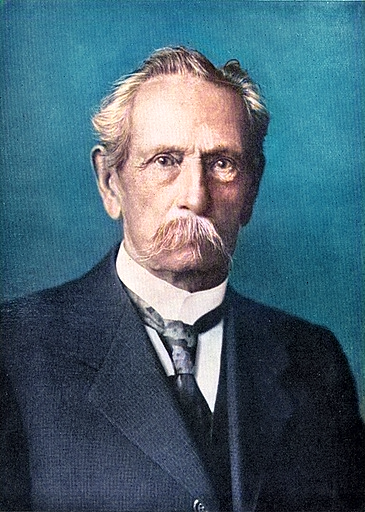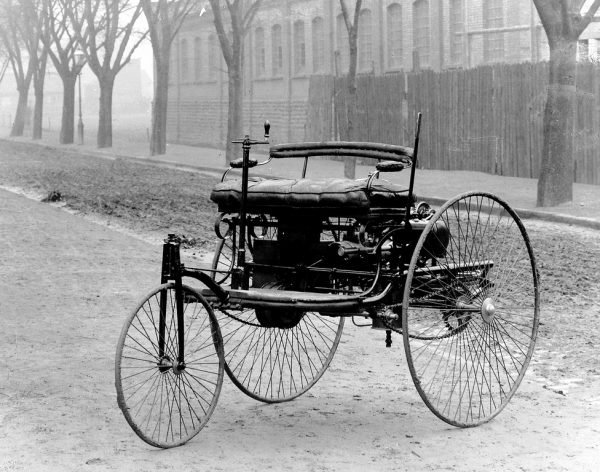
Carl Benz (1844 – 1929)
On January 29, 1886, German engineer and entrepreneur Carl Friedrich Benz patented the first successful gasoline-driven automobile, the Benz Patent-Motorwagen 1. It was granted as DRP Nr. 37435 on November 12, 1886. His patent motor car still reminds in many ways of bicycles and carriages.
“My first customer was a lunatic. My second had a death wish.”
– Carl Benz, in [8]
Carl Benz – Youth and Education
Carl Friedrich Benz was born as Carl Friedrich Michael Vaillant into a family of a locomotive driver and a maid – the couple married a few month after carl’s birth – and after his father passed away two years later, his mother had to work hard to finance carl’s education. From 1853 Benz visited the natural science-oriented Karlsruhe Lyceum. His mother couldn’t live on her meagre widow’s pension alone. She awarded board and lodging to students of the Polytechnic in Karlsruhe. So she also financed the education of her son. In 1860,15-year-old Carl Friedrich passed the entrance examination at the Polytechnikum Karlsruhe, from where he graduated in 1864.
After focussing on locksmithing, Benz decided to go into locomotive engineering and developed his early concepts for the horseless carriage shortly after. In the early 1870’s, Benz launched the Iron Foundry and Mechanical Workshop in Mannheim along with August Ritter, but after a rough start their machines were impounded and only Bertha, Carl’s later wife could rescue the company with financial aid through buying Ritter’s shares.
The Development of the Internal Combustion Engine
Even though their business start was critical concerning financial issues, Carl Benz was able to push the development of engines forward, especially focusing on a petrol two-stroke engine, which was finished on New Year’s Eve in 1878. The curious inventor was able to patent the engine and its design as well as speed regulation systems, the water radiator, the gear shirt and further features needed to succeed on the market. In 1878/79 Carl Benz developed a two-stroke engine without compression and later on a light four-stroke engine. Benz further developed the differential drive and other automotive components such as the steering knuckle steering, the spark plug, the belt shift as a clutch, the carburetor, the water cooler and the gear shift.
Because of the financial struggles, the Benz’ had to transfer their business into a stock company with the effect that most members of the supervisory board disliked his new ideas and inventions if they were not obviously financially promising. After all the necessary incorporation agreements, Benz was unhappy because he was left with merely five percent of the shares and a modest position as director. Worst of all, his ideas weren’t considered when designing new products, so he withdrew from that corporation just one year later, in 1883.
The Horseless Carriage
In 1883, together with Max Rose and Friedrich Wilhelm Eßlinger, who owned a bicycle repair shop, Benz founded a new company producing industrial machines: Benz & Companie Rheinische Gasmotoren-Fabrik, usually referred to as Benz & Cie. Quickly growing to twenty-five employees, it soon began to produce static gas engines as well. The success of the company gave Benz the opportunity to indulge in his old passion of designing a horseless carriage.

The Benz Patent-Motorwagen (1885)
The Benz Patent Motorwagen
Based on his experience with, and fondness for, bicycles, he used similar technology when he created an automobile. It featured wire wheels with a four-stroke engine of his own design between the rear wheels, with a very advanced coil ignition[10] and evaporative cooling rather than a radiator. Power was transmitted by means of two roller chains to the rear axle. Carl Benz finished his creation in 1885 and named it “Benz Patent Motorwagen“.[4] It was the first automobile entirely designed as such to generate its own power, not simply a motorized stage coach or horse carriage, which is why Carl Benz was granted his patent and is regarded as its inventor. Benz began to sell the vehicle (advertising it as “Benz Patent Motorwagen”) in the late summer of 1888, making it the first commercially available automobile in history.
Benz’s difficulties not only were not only restricted to financial issues, but also concerned the general public, which confronted Benz’ company with mockery and contempt for his carriages without horses. Nevertheless, Benz worked continuously on the advancement of his technologies. Times of upheaval set in, when Bertha Benz drove von Mannheim to Pforzheim without her husband knowing with the Patent-Motorwagen Nr. 3. She arrived after 12 hours and caused a great public attention convincing the people of Benz’ new developments. But this is a whole different story. [3]
Entrepreneurial Success
In 1899, Benz & Cie. Rheinische Gasmotorenfabrik Mannheim was converted into a public limited company (Benz & Cie. AG). Around 1900 it was the largest automobile factory in the world. Despite the enormous success, Benz withdrew from the company in 1903. In 1906 Carl Benz and his sons founded the company Carl Benz & Söhne in Ladenburg, which specialized in vehicle construction. Carl Benz was awarded an honorary doctorate by the Karlsruhe University of Technology in 1914. In 1926, Benz & Cie. Rheinische Gasmotorenfabrik Mannheim and the Daimler-Motoren-Gesellschaft founded by Gottlieb Daimler merged to form Daimler-Benz AG.
Carl Benz died on 4 April 1929 at the age of 84.
Jon Summers, 1. Cars: Past, Present, Future, [8]
References and Further Reading:
- [1] Bertha Benz Website
- [2] Karl Friedrich Benz: Lebensfahrt eines deutschen Erfinders. Autobiografie
- [3] On the Road with Bertha Benz, SciHi Blog, August 5, 2018.
- [4] The Benz Patent-Motorwagen No.1, SciHi Blog, November 2, 2017.
- [5] Carl Benz at Wikidata
- [6] Patent 37435, by Carl Benz for his 1885 Motorwagon
- [7] Carl Benz at inspiringquotes.us
- [8] Jon Summers, 1. Cars: Past, Present, Future, 2012, Stanford @ youtube
- [9] Newspaper clippings about Carl Benz in the 20th Century Press Archives of the ZBW.
- [10] “Benz Patent Motor Car: The first automobile (1885–1886)”. Daimler.com.
- [11] Benz, Carl (2001). Lebensfahrt eines deutschen Erfinders : meine Erinnerungen / Karl Benz. München: Koehler und Amelang.
- [12] Seidel, Winfried A. (2005). Carl Benz : eine badische Geschichte; die Vision vom “pferdelosen Wagen” verändert die Welt. Weinheim: Ed. Diesbach.
- [13] Timeline of Mercedes Benz automobiles, via Wikidata






Its really good biography on benz and it is good to hear that, he will invent a car which can run without horse in the 1870’s.
Lone Mountain Truck Leasing